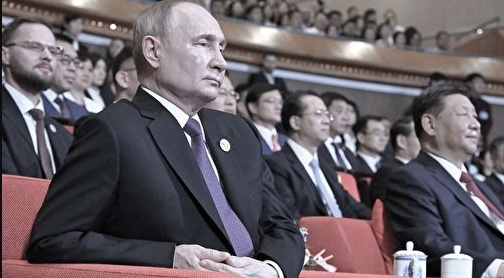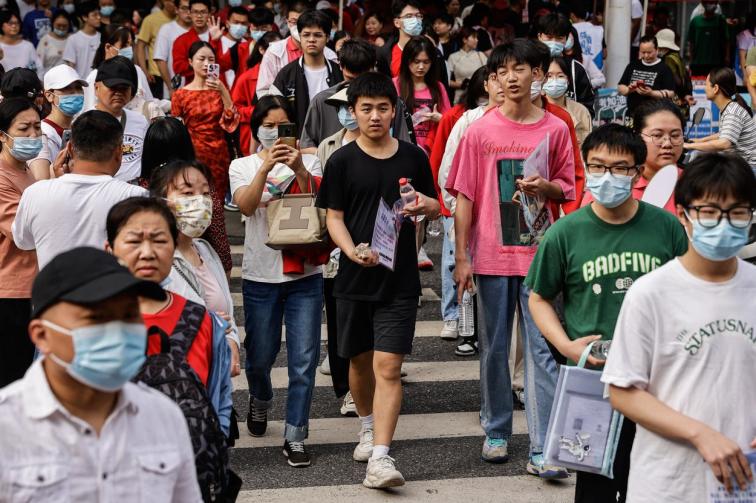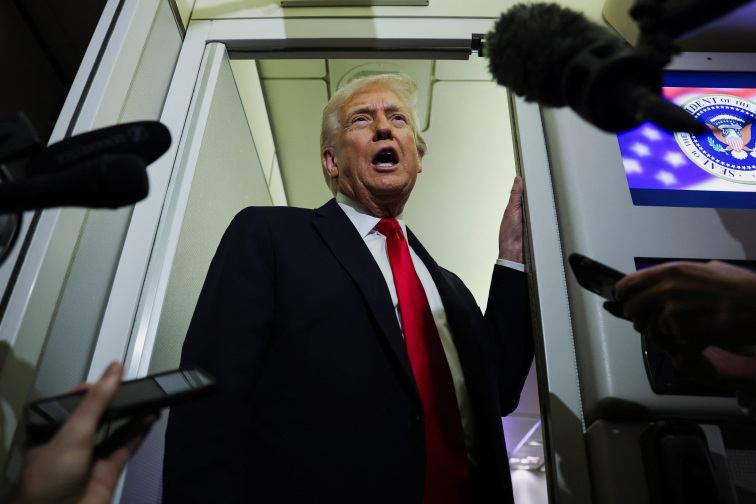On the afternoon of May 16, 2024, Putin (front left) attended a concert in Beijing commemorating the 75th anniversary of China-Russia (Soviet) diplomatic relations. His gaze was unfocused on the performance, appearing deep in thought. Putin&9;s body also leaned slightly away from Xi Jinping (front right, second from the right).
[People News] Recently, the U.S. proposed a peace plan for the Russia–Ukraine war. Ukrainian President Zelensky has largely agreed to the negotiation terms, but Putin is still hesitating. Commentators are perplexed and suspect that U.S. President Trump may be secretly coordinating with Putin. The true purpose remains to be analyzed further.
1. Trump Finds He Cannot Benefit From the Russia–Ukraine War
According to Russia’s news agency, Trump stated that Kyiv should reach an agreement with Moscow to resolve the conflict, given Russia’s advantage in troop size.
Chinese writer Deng Yuwen, now residing in the U.S., said the Russia–Ukraine war is unfavorable to Trump’s principle of “America First.” Considering Ukraine’s disadvantages in territory, population, economy, and weaponry, even with U.S. support, Ukraine is unlikely to win if the war continues. The resources the U.S. has invested over the years have brought no material return, making it an unprofitable deal.
According to a Council on Foreign Relations (CFR) summary, since the outbreak of war, U.S. aid commitments for the Ukrainian government amount to about $128 billion. Independent statistics indicate that from February 2022 to the end of 2024, U.S. “emergency aid” to Ukraine totaled $182.8 billion, exceeding the commitment figure. Based on U.S. congressional supplementary appropriations from FY2022–2024, total U.S. allocations to Ukraine amount to about $174.2 billion, of which around $83.4 billion has been actually spent, with the remainder including weapons and medical supplies.
In short, Trump likely sees that despite the Biden administration fulfilling its promised support, the Russia–Ukraine war still shows no sign of stopping.
On October 29, Putin announced Russia had tested a new nuclear-powered unmanned underwater drone “Poseidon” and the nuclear-powered cruise missile “Burevestnik.” Russia also launched a new nuclear-powered submarine, the Khabarovsk, which will carry Poseidon drones.
In November 2020, Christopher Ford, then U.S. Assistant Secretary of State for International Security and Nonproliferation, stated that the “Poseidon” was designed to “flood U.S. coastal cities with radioactive tsunamis.” Michael Petersen, chief scientist at the Russia military studies program at the U.S. Naval War College, emphasized that even if Russia’s nuclear arsenal were destroyed, the Khabarovsk’s 16 MIRVed ballistic missiles would still ensure effective second-strike capability.
In other words, if the U.S. keeps supporting Ukraine, it could become mired in a long-term conflict with Russia.
Trump proposed exchanging Ukraine’s rare earths and energy resources for U.S. aid. On February 3, 2025, Trump said at the White House he hoped Ukraine’s “vast rare earth and mineral resources” could serve as “equalization” for past and ongoing U.S. support. In March 2025, Trump publicly stated that a U.S.–Ukraine “minerals deal” would be signed “very shortly.”
But more importantly, the Russia–Ukraine war prevents the U.S. from disengaging from Europe and focusing fully on competition with the CCP. If, under Trump’s pressure, the war can be ended quickly—even at the cost of some Ukrainian interests—the U.S. would gain valuable time to confront the CCP, which benefits U.S. strategy.
2. Putin Is Still Hesitating—He Wants More
On November 21, Russian President Putin told the Russian Security Council that Russia had received the U.S. draft plan but had not yet held substantive discussions. Putin said the document could serve as the basis for a final settlement. He stated that although the frontline situation generally favors Russia and allows it to achieve goals of the “special military operation,” Moscow remains open to negotiation and peaceful resolution. Possible concessions include a ceasefire and halting Russia’s further advances.
Trump said: “This war could go on for years. Russia has far more people, far more soldiers. I think if Ukraine can reach an agreement, that’s good. Honestly, I think it’s good for both sides. Ukraine’s population is much smaller.”
Earlier, the U.S. and Ukraine met in Geneva on the 23rd. Based on the U.S.’s 28-point peace plan, they developed a new 19-point proposal reflecting Ukraine’s position. On the 25th, the BBC and CBS quoted senior U.S. officials saying: “Ukraine has agreed to the U.S. peace plan. Only a few minor details need to be coordinated.”
But since Russia has not announced its official stance, major differences remain—such as territorial issues and Ukraine’s potential NATO membership—so many remain cautious.
3. If the U.S. Aligns With Russia Against the CCP, Xi Jinping Will Be Completely Finished
Currently, the CCP is beset by internal and external crises. On the 20th, Zhang Youxia traveled to Russia, but reports were suppressed by CCP authorities, with only National Defense News and PLA Daily briefly mentioning it. Propaganda chief Cai Qi—Xi’s close ally—clearly suppressed coverage, indicating his intent.
Sources in China’s political circles told overseas media Vision Times that Zhang Youxia’s trip to Russia was directed by the “Hu-Wen faction.” They claim that China’s internal power structure has shifted: Wang Yang overseeing Party affairs, Liu Yuan controlling military affairs, Hu Chunhua running administration, Zhang Shengmin overseeing military discipline, and Liu Zhenli handling operational command of the PLA.
Under this framework, Zhang Youxia’s sudden visit to Russia serves two purposes:
-
To assure Putin that even though Xi Jinping has lost real power, China will continue supporting Russia;
-
To prevent Russia from fully turning toward the U.S.
Even if Zhang Youxia’s faction or the Hu-Wen faction attempts to save the CCP regime, such efforts may be futile under a potential U.S.–Russia alignment. A divided China aligns better with the expectations of both the U.S. and Russia.
(People News original publication) △











News magazine bootstrap themes!
I like this themes, fast loading and look profesional
Thank you Carlos!
You're welcome!
Please support me with give positive rating!
Yes Sure!